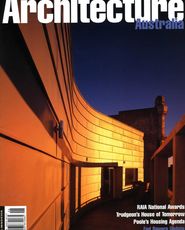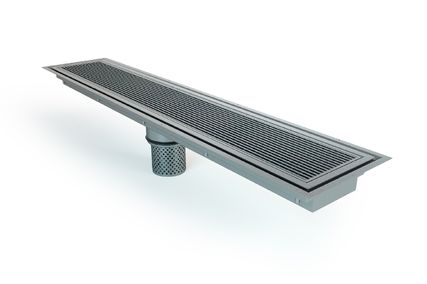As architects, we have really failed our
masters—the population of this could-be-great
country. We have neglected our most
important purpose: to house our people. I
believe that if we house people better, we
will grow better people. Many in our profession bemoan the loss of
large projects to large design-and-construct
companies and constantly seek ways of
recouping this work. But little is done about
reforming the housing sector. I know there
are endless conferences and high-sounding
talk, the best intentions and some quite
wonderful ideas, but we are not going to
the coal face and actively confronting
the problems. What is the use of our fine ideas if they
don’t reach the people? To do this, we must
have our theories and ideas built and tested
by the public and that means we have to
access the large building companies, take
control of large building companies or just
get out there and build our beliefs.
I am endeavouring to get out there and build
my beliefs, with considerable small-scale
success. Maybe what I’m doing seems
primitive. You may well say: ‘silly old bastard
lives in the dark ages’. Or maybe the
seemingly simplistic approach of a small
and aging architect might have some value
in a society where most housing is politically
driven, where the really important projects
go to large firms, and where the small firms
which are closer to the coal face and maybe
more acutely aware of the problems, are
generally ignored. Because we have neglected the humble
house and headed for the large building,
large profit and large ego boost, the
domestic housing market has been almost
completely hijacked by big business—
whose aim, to my mind, is to provide the
maximum amount of generally useless
space at certainly affordable prices. We, for our part, have chosen to settle for the one-off house, often for rich clients, with
the main object, as I see it, of scoring the
Robin Boyd Award and so again give the old
ego a marvellous massage. The houses which have taken over the
market are generally gross but do satisfy
their occupants. It’s what I call the three
little pigs syndrome: if it is brick and tile, it is
security: to hell with anything else. The other apparent necessity is that a house
should impress the visitor. It is our status
symbol and we stuff it with art and
expensive furniture to display to the world. If
the house does not work, we further stuff it
with ceiling fans and air conditioners.
Regularly, what the architect thinks looks
good and artistic subjugates practicality
or purpose. [There is a story on practicality, as seen
through the eyes of an elephant having a
discussion with a naked man. Suddenly the
elephant looked down and asked: ‘how in
the hell to you feed yourself with that?’] To me, the origins of the house now
swamping the marketplace, at least in our
area of Queensland, generally lie in the
travelling habits of the Melbourne bowler.
From the time I was very young, they began
invading Queensland in large numbers, from
the beginning of May to the end of
September. I became acutely aware of this
when I moved to the Sunshine Coast, where
the word among the locals was that the
bowlers arrived with a clean shirt and a 10
bob note and they never changed neither. It was Victorian money and the Victorian way
which shaped our coastal tourist areas, and
the early effects on places like Noosa were
considerable. Large brick houses with tile
roofs were injected into a community of
lightweight fibro or timber weatherboard-clad
fishermans’ shacks and holiday houses.
With them came the opulence of the south
and the requirement for ceiling fans and air
conditioning. The houses were not designed for the climate; rather the climate was
expected to bend to the will of the Mexicans. | The greater part of our environment still
follows these lines. Queensland architects
were becoming aware of the climate they
had to deal with, were orienting houses to
the north-east, providing wide eaves and
exploring methods of cross-ventilation, but
they were firmly stuck in the one-off market.
Attempts were made at prefabrication and
project building, but were generally so far
oriented to architectural flair that the results
were not recognised by the public as real
houses—so architects have had little to do
with seriously housing the Australian family.
It is true that we still have some effect on the
market, when our ideas are taken and
reused (generally badly) by project home
builders—but it is minimal impact and we
are losing more ground by the day. By and large, the public has little respect for
the profession and even less confidence in
our abilities to provide a basic service:
suitable housing at acceptable cost.
We are now considering what may be the
needs of a family by the year 2020. By then,
we will probably see three generations of
family reunited under one roof and I believe
that we should be designing houses with
this in mind. The one and only advantage of aging is the
gaining of wisdom. By selfishly removing
ourselves (the over 55s) to retirement
villages, we deprive the young of what
wisdom, knowledge and experience we have
gained. If we can reunite our families to
share the loads and costs of existing, and to
share our knowledge and experiences, we
may be heading for a better world. The house can play an important role in this
and we have consciously developed
Capricorn housing so that it may be
arranged to meet their needs. Where I design one-off housing, I endeavour
to influence the clients towards designs which may serve the needs of the future. We architects, for our part, have a
responsibility to raise the status quo and to
endeavour to forward plan for the needs of
all people—for all people should be
considered our clients. We must have the ability to create simple
spaces and volumes which can raise the
spirit of those who inhabit them and
accommodate the different generations of
a family within a house; providing them with
privacy and dignity. Why in the hell can’t we inject a bit more
humanity into our architecture? Why do we
attempt, so often, to force onto our clients
and the public our personal fancies; which
are generally aimed at ego boosting? We are all too often seen as rigidly set in a
particular style, or even fashion, and clients
are often advised that if they don’t do things
our way, we will not accept the brief. Every client is an individual and every
individual has a different set of requirements.
Each site is different and has its own set of
circumstances. It seems to me that each
house can be different in form and concept. For many years now, I have endeavoured to
create a product which could raise standards
in housing and lift the spirits of occupants.
Until a couple of years ago, my attempts
had failed but I now find myself making
some ground. The houses sold under the banner of
Capricorn 151 are modest. They are well
designed, they are affordable and they seem
to have captured the spirit of Australia. We
are now selling them at the rate of around
two a week—which is admittedly a small
dent in a huge market. But if I could convince
a further 100 of you architects to each build
and move 100 dwellings a year, consider the
level to which we might elevate the humble
house throughout our society. And consider the possibility that we might
just touch the consciousness of a nation. |
















